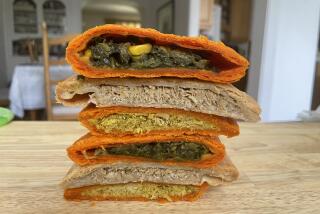Poi: A Hawiian Institution Takes Its Fair Share of Lumps
- Share via
All the Polynesians eat it!
--Flossie Bobbsey on poi, “The Bobbsey Twins in Volcano Land”
It can be white, pink, purplish or even gray; it’s said to taste like wallpaper paste; and, like Don Ho, it is a Hawaiian institution. It’s poi and few tourists ever leave the islands without at least a taste of the stuff. Still fewer understand why the odd goo is such a beloved dish.
“Nine times out of 10, tourists have just a bite of poi --no more than that,” says chef Roy Yamaguchi (formerly of Los Angeles’ 385 North, now of Roy’s in Honolulu). “ Poi is one of those flavors and textures that you have to have when you’re very young. It’s hard to get accustomed to.”
Or as Trader Vic wrote in his “Pacific Island Cookbook”: “Americans do not appreciate food which is too far out.”
Debbie Murata and Chris Hang work at the Ala Moana shopping center in Honolulu. Both are 22 and were raised in Hawaii. They sling poi-- and other Hawaiian specialties--for a living . . . in a restaurant called the Poi Bowl. Yet even they are divided on poi.
Murata thinks poi is swell. But Hang, 10 minutes into a telephone conversation on the appeal of poi , admits, “I don’t care for it myself--it’s just like this slime going down your throat . . . and it doesn’t have any taste . . . and, uh, maybe you should talk to someone who likes poi .”
At this point, Murata comes on the line: “Sure it can be bland, but that’s when it’s fresh. I like it sour.”
To make poi , taro root is pounded and mixed with water until it gets mushy, like lumpy mashed potatoes, and then it’s left to ferment a while. Like wine, poi seems to get better with age.
At the Poi Bowl, though, no poi older than two days is served. “Old poi is only for the employees,” Murata says, “and for the locals who ask for it.”
The mush you might have been served at a hotel luau was almost certainly not aged, and probably served plain, which is the rough equivalent of eating potatoes mashed without butter or cream.
“I like poi with sugar,” Murata says. So does Roy Yamaguchi: “When I was a kid I used to mix it with sugar and wash it down with Coke.”
Thickness is said to be another important poi variable: food and travel books are full of rosy-prosed discussions of charming natives scooping up one-finger, two-finger and three-finger pois , each symbolizing a different level of thickness.
I ask Murata what she prefers.
“Fingers?” she says and pauses for a moment. “Oh no, we just use spoons.”
More to Read
Eat your way across L.A.
Get our weekly Tasting Notes newsletter for reviews, news and more.
You may occasionally receive promotional content from the Los Angeles Times.










